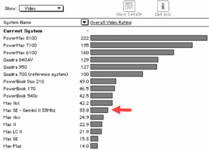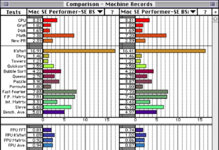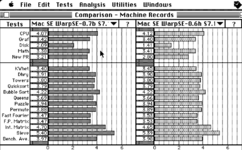I love making the lowly SE faster, since that was my first computer back in the late 80s and early 90's, and accelerator boards were an economical upgrade path compared to the $4,000+ dollars for a loaded SE/30 from the college bookstore.
So I am always on the lookout for cool SE accelerators. I was blessed to become the new steward of a Total Systems Gemini II accelerator (engineered by Quesse) purchased from @nekogahora280 after bricking my previous 16Mhz Gemini 020/030. After my previous experience, I was a bit hesitant to risk bricking another rare board, but old accelerators are fraught with risk, and risk is part of the hobby . Here are my findings and spoiler alert, it did not end with disaster this time.
. Here are my findings and spoiler alert, it did not end with disaster this time.

In the near future (stay tuned), I am planning to test with 4MB SIMMS and use the compatible Compact Virtual to see if I can address the 16MB of RAM that is reportedly possible.
Theory: I think the helpful note from Jurassic Computing may apply - " systems may only work with 4MB modules with 8 or 9 chips (11 address lines A0-A10 available)"
Compared to my older Gemini 020/030 board, the Gemini II seems more robust and tolerates experimentation well. It is also even faster than the quick, modern MacEffects Performer (clone of the MicroMac Performer) for the SE. (Side Note - All SE owners should buy a MacEffects Performer!)

CPU

Video/Graphics

FPU


---
Related thread: https://tinkerdifferent.com/threads...-020-to-030-for-macintosh-se.4437/#post-39011
So I am always on the lookout for cool SE accelerators. I was blessed to become the new steward of a Total Systems Gemini II accelerator (engineered by Quesse) purchased from @nekogahora280 after bricking my previous 16Mhz Gemini 020/030. After my previous experience, I was a bit hesitant to risk bricking another rare board, but old accelerators are fraught with risk, and risk is part of the hobby
Clock Speed Upgradeable?
The crystal oscillator can be replaced on the Gemini series of accelerators. Using a 50Mhz 68030 and 40 Mhz 68882 from reliable sources, I tried FOX oscillators at 50 Mhz and 40 Mhz, but could not get the board to boot no matter what setting or memory configuration was tried. In the end, 33 Mhz clock speed is the only speed that would boot on this Gemini II, which is consistent with Earl Grey's Mac Plus Gemini II findings. In the day, the Gemini II was offered in 33, 40, or 50Mhz configurations, but I could find no certain information that it was possible to consistently upgrade the speed of an existing 33Mhz Gemini II by simply replacing the clock and CPU/FPU. The later Gemini Ultra, had improvements to make the board more upgradeable to higher clock speeds.Memory
The faster accelerators for SE have their own onboard fast RAM with a 32 bit data path to the 68030 CPU. But bypassing the SE's onboard RAM required some complex engineering with programmable logic array (PLA) chips. Therefore, not all 30 pin SIMMS work with the on-board memory on this card. For example, modern, fast, high quality Jurassic Computing 2-chip 60ns SIMMS would not work. The board came with 80ns RAM, but I wanted to use 70ns RAM to experiment with lower wait states. The 70ns 1MB SIMMS that came with my old Gemini 020/030 accelerator worked well at 2 wait states (P4 jumpers removed), so I assume this RAM was handpicked by Quesse to work with their board.In the near future (stay tuned), I am planning to test with 4MB SIMMS and use the compatible Compact Virtual to see if I can address the 16MB of RAM that is reportedly possible.
Theory: I think the helpful note from Jurassic Computing may apply - " systems may only work with 4MB modules with 8 or 9 chips (11 address lines A0-A10 available)"
Performance
This is a quick but not blazing board that subjectively feels faster than a stock SE/30. I really do like this board and it makes the SE much faster overall, but it is not a rocket like the Gemini Ultra.Compared to my older Gemini 020/030 board, the Gemini II seems more robust and tolerates experimentation well. It is also even faster than the quick, modern MacEffects Performer (clone of the MicroMac Performer) for the SE. (Side Note - All SE owners should buy a MacEffects Performer!)
Norton System Info 3.2.1 Benchmarks (Tested on System 7.1.1)
Overall System RatingCPU
Video/Graphics
FPU
Speedometer 3.2.3 Benchmarks (System 7.1.1)
Speedometer 3 is not a consistent benchmarking tool, as I've found its results may vary widely from run to run. Nevertheless, here is a comparison with another 33Mhz Mac, the later speed-bumped LCIII.---
Related thread: https://tinkerdifferent.com/threads...-020-to-030-for-macintosh-se.4437/#post-39011
Attachments
Last edited:



